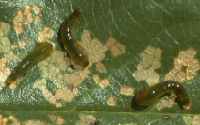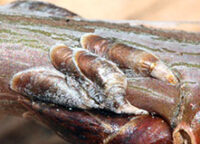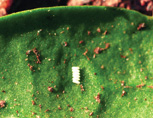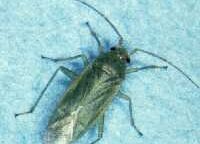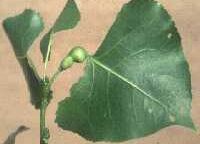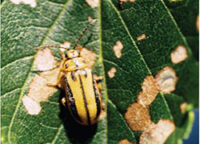- 08, 11, 2015
- No Comments.
- By
Pear Slugs – 5.560
Print this fact sheet by W.S. Cranshaw and D.A. Leatherman* (7/14) Quick Facts… Pear slugs chew the leaves of many common trees and shrubs such as cotoneaster, cherry and related plants. Pear slugs are not true slugs. They are a type of insect known as sawflies. Two generations of pear slug occur. Most damage usually […]
Take a Tour- 08, 11, 2015
- No Comments.
- By
Oystershell Scale – 5.513
Print this fact sheet by W.S. Cranshaw * (5/13) Quick Facts… Oystershell scale develops on the bark of many common trees and shrubs and can cause serious injury during outbreaks. Oystershell eggs typically hatch in late May or early June and the active ‘crawlers’ that emerge move about to find new sites to feed. Sprays […]
Take a Tour- 08, 11, 2015
- No Comments.
- By
Mountain Pine Beetle – 5.528
Print this fact sheet by D.A. Leatherman, I. Aguayo, and T.M. Mehall* (9/11) Quick Facts… Mountain pine beetles (MPB) are the most important insect pest of Colorado’s pine forests. MPB often kill large numbers of trees annually during outbreaks. Trees that are not growing vigorously due to old age, crowding, poor growing conditions, drought, fire […]
Take a Tour- 08, 11, 2015
- No Comments.
- By
Leafmining Insects – 5.548
Print this fact sheet by W.S. Cranshaw, D.A. Leatherman and J.R. Feucht* (7/14) Quick Facts… Leafminers are insects that feed within a leaf, producing large blotches or meandering tunnels. Although leafminer injuries are conspicuous, most leafminers produce injuries that have little, if any, effect on plant health. Most leafminers have many natural controls that will […]
Take a Tour- 08, 11, 2015
- No Comments.
- By
Ips Beetles – 5.558
Print this fact sheet by W. Cranshaw and D.A. Leatherman* (6/13) Quick Facts… Ips is a common group of bark beetles that infests pine and spruce trees. Ips beetles rarely attack healthy trees. Most problems with ips occur to newly transplanted pines or when plants are under stress. Several generations of ips can occur in […]
Take a Tour- 08, 10, 2015
- No Comments.
- By
Insect and Mite Pests of Honeylocust – 5.571
Print this fact sheet by W.S. Cranshaw * (6/13) Quick Facts… Several Insects and mites are commonly found on honeylocust trees in Colorado. However, they rarely affect the health of the tree. Honeylocust podgall midge deforms new leaves of honeylocust in late spring. One to two insecticide applications when new growth starts can limit this […]
Take a Tour- 08, 10, 2015
- No Comments.
- By
Insect and Mite Galls – 5.557
Print this fact sheet by W.S. Cranshaw* (6/13) Quick Facts… Figure 1: Thickening of the petiole produced by poplar petiole gall aphids. Photograph by D. Leatherman. Figure 2: Galls produced by the hackberry nipplegall psyllid. Figure 3: Severe galling produced by the honeylocust podgall midge. Galls are abnormal growths of plant tissue caused by a […]
Take a Tour- 08, 10, 2015
- No Comments.
- By admin
Elm Leaf Beetles – 5.521
Print this fact sheet by W.S. Cranshaw* (1/18) Quick Facts… Adult elm leaf beetles chew holes in elm leaves. The larvae feed on the leaf surface, producing skeletonizing injuries that make leaves look lacy. Adult elm leaf beetles often spend winter in and around buildings and may be common nuisance invaders found within homes during […]
Take a Tour- 08, 10, 2015
- No Comments.
- By admin
Douglas-fir Tussock Moths – 5.542
Print this fact sheet by W. Cranshaw* (1/20) Quick Facts… Douglas-fir tussock moth caterpillars feed on needles of spruces, Douglas-fir and true firs. Numerous natural enemies attack Douglas-fir tussock moth and these will often control outbreaks after a season or two. A virus that produces “wilt disease” is a particularly important natural control. The potential […]
Take a Tour- 08, 10, 2015
- No Comments.
- By
Cooley Spruce Galls – 5.534
Print this fact sheet by W.S. Cranshaw* (6/13) Quick Facts… Cooley spruce galls are common and conspicuous on blue spruce. However, they do little or no harm to the tree. The galls are produced by aphid-like insects, Cooley spruce gall adelgids. Cooley spruce gall adelgids require two hosts to complete their normal life cycle: spruce […]
Take a Tour
